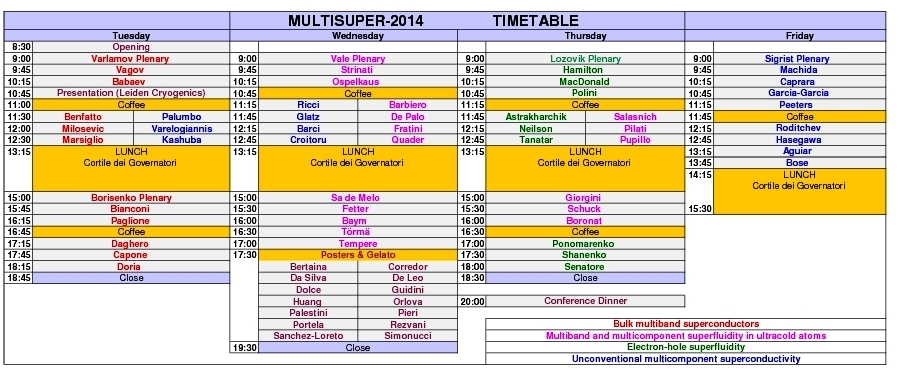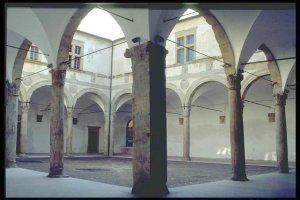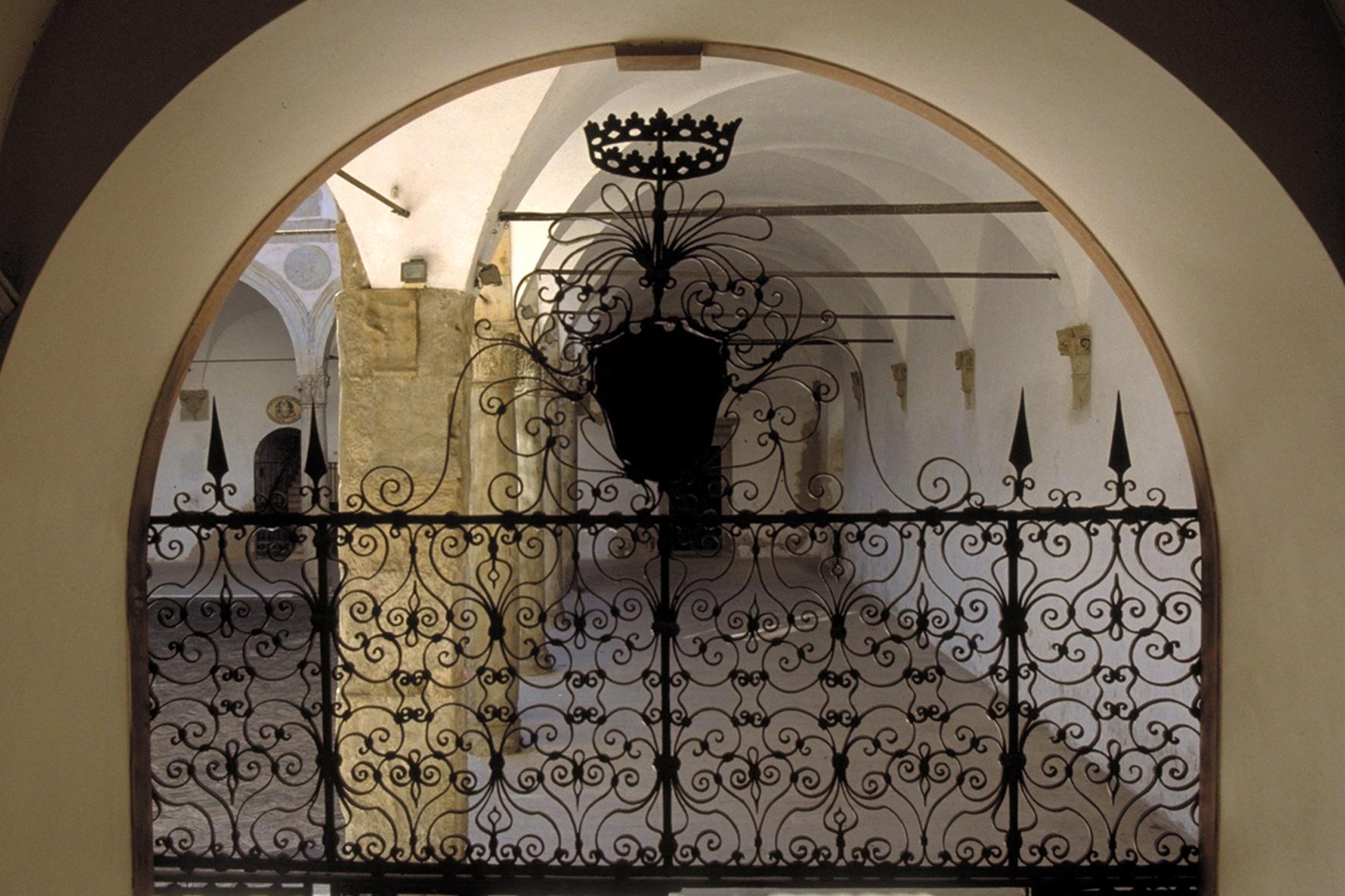The
Second International Conference on Multi-Condensate Superconductivity and
Superfluidity in Solids and Ultracold Gases
was held at the historic University of
Camerino (1336) in the medieval hilltop town of
The first in this conference series was held in
Top
Conference Topics:
|
Video Recordings of Talks (Click) Book of Abstracts [5 Mb] (Click) Top |
| The Conference Venue was the Ducal Palace (Palazzo Ducale) on the main square (Piazza Cavour) in the centre of Camerino |
|
Participants Grigory Astrakharchik (Universitat
Politècnica Catalunya, Barcelona, Spain) Egor Babaev ( Luca Barbiero (University
of Padua, Italy) Daniel Barci (Universidade
do Estado do Rio de Janeiro, Brazil) Gordon Baym (University
Lara Benfatto (ISC-CNR
and Sapienza University of Rome, Italy) Gianluca Bertaina ( Antonio Bianconi (RICMASS, Rome, Italy) Giacomo Bighin ( Luca Boarino
(Istituto Nazionale Ricerca Metrologica, Turin, Italy) Sergey Borisenko (Leibnitz Institute, Dresden, Germany) Jordi Boronat (Universitat Politècnica Catalunya, Barcelona, Spain) Sangita Bose (Mumbai University, India) Massimo Capone (SISSA and
CNR-IOM Democritos, Trieste, Italy) Sergio Caprara (Sapienza University of Rome, Italy) Laura Corredor (Universidade
Federal de Pernambuco, Brazil) Mihail Croitoru ( Dario Daghero (Politecnico di Torino, Italy) Rogerio Da Silva (Universidade
Federal de Pernambuco, Brazil) Natascia De Leo
(Istituto Nazionale Ricerca Metrologica, Turin, Italy) Stefania De Palo (CNR-IOM Democritos & Donatello Dolce (University
of Camerino, Italy) Mauro Doria (Universidade do Estado do Rio de
Janeiro, Brazil) Alexander Fetter (Stanford University, USA) Elisa Fratini (ICTP, Trieste, Italy) Giorgio Frossati (Leiden Cryogenics, Netherlands) Antonio Garcia-Garcia (Universities of Cambridge, UK & Lisboa, Portugal) Stefano Giorgini ( Andreas Glatz (Argonne National Andrea Guidini ( Alexander Hamilton ( Yukio Hasegawa ( Zhao Huang (NIMS and Oleksiy Kashuba (Technische Yurii Lozovik (Institute Spectroscopy, Allan MacDonald ( Kazushige Machida ( Pieralberto Marchetti (University
of Padua, Italy) |
Milorad Milosevic ( Riccardo Natali (University of Camerino, Italy) David Neilson ( Natalia Orlova ( Silke Ospelkaus ( Johnpierre Paglione (University Fabrizio Palestini (University
of Camerino, Italy) Fabrizio Palumbo (INFN Laboratorio Nazionali di Frascati, Italy) François Peeters (University
Andrea Perali ( Pierbiagio Pieri (University of Camerino, Italy) Sebastiano Pilati (ICTP, Nicola Pinto ( Marco Polini (NEST and SNS, Pisa, Italy) Leonid Ponomarenko ( Flavia Portela (Universidade
Federal de Pernambuco, Brazil) Guido Pupillo ( Khandker Quader ( Seyed Javad Rezvani ( Alessandro Ricci (DESY,
Hamburg, Germany) Dimitri Roditchev (University
Paris 6 - CNRS, Carlos Sa de Melo (Georgia
Tech, Luca Salasnich ( Pedro Sanchez-Lotero (Universidade Federal de Pernambuco, Peter Schuck (LPMMC & Institute Physics Nuclear Arkady Shanenko (Universidade Federal de Pernambuco, Gaetano Senatore (University
Manfred Sigrist (ETH, Stefano Simonucci (University
of Camerino, Italy) Giancarlo Strinati (University Camerino, Italy) Bilal Tanatar (Bilkent University, Jacques Tempere ( Paivi Torma (Aalto
University, Helsinki, Finland) Chris Vale ( Alexei Vagov ( Georgios Varelogiannis (National Technical | |
| Scientific Committee
David Neilson ( Andrea Perali ( Milorad Milosevic ( Arkady Shanenko ( |
| Organising Committee David Neilson <david.neilson {at} unicam.it> Andrea Perali <andrea.perali {at} unicam.it> Fiorella Paino <fiorella.paino {at} unicam.it> |
Background
Discovery of superconductivity in MgB2 in 2001 had
marked the appearance of a new class of superconductors - multiband (multigap) superconducting materials. Multigap superconductivity arises when the
gap amplitudes on different sheets of the Fermi surface are radically
disparate, e.g. due to different dimensionality of the bands for the usual
phonon-mediated pairing, as in the case of MgB2, or due to the
repulsive interband pairing interactions, as in the case of most iron-based superconductors, or due to the
appearance of multiple Fermi-surface pockets dictated by the crystalline symmetry
like in FeSexTe1-x
and other unconventional multiband superconducting compounds. In all such
systems it is of abiding interest to understand how multiple condensates affect
the macroscopic properties of samples. In other words, it is important to know in
which cases different band-condensates work cooperatively and in which
destructively for particular phenomena of interest. This is the key objective
of the conference series "MultiSuper". The first in this conference
series was held in
Interestingly enough, even single-band superconductors and fermionic superfluids can become effectively multiband, in samples confined to nanoscale. In such systems, their physical properties can be tailored by their geometrical shape and dimensions beyond any previous possibility, provided that the understanding of background physics and all competing phenomena is achieved. In particular, quantum confinement of the perpendicular motion of electrons in nanothin films splits the conduction band into a series of single-electron subbands, i.e. an effectively multiband scenario. Thus, before eventually becoming suppressed in lower dimensions, superconductivity exhibits an almost unexplored regime governed by quantum confinement, i.e., the nanoscale multiband superconductivity.
Cooling of trapped fermionic atoms down to ultra-low temperatures of the Fermi degeneracy resulted in another kind of systems that is very promising for investigations of the multiband aspects in the coherent phenomena. In the case of trapped atomic Fermi gases the single-particle levels can be widely and very precisely manipulated by laser light or magnetic fields through, e.g., changing the spatial dimensions of a trap. In particular, for a pancake- and cigar-shaped geometry the perpendicular trapping frequency can be chosen much larger than the parallel one. In this case the single-particle states form well distinguished subbands and the physical picture in the trapped quasi-1D and quasi-2D effectively multiband superfluids turns out to be similar to the above-described case of high-quality superconducting nanofilms and nanowires.
Another very promising possibility is to invoke the multi-component condensate complexity by adding extra degrees of freedom, e.g., combining several quantum species of particles with different statistics or with different properties. Such artificial multi-component coherent systems include fermions with spin population imbalance, fermi-fermi and fermi-bose mixtures. Excitonic condensates driven by an inter-layer direct Coulomb interaction form yet another extremely interesting example of a multi-component coherent system. Highly-debated issue here is the possibility to obtain room-temperature superfluids. Recently, this issue was discussed and investigated for the double-monolayer graphene, for the double quadratic bilayer graphene, and hybrid monolayer-bilayer graphene systems.
|







